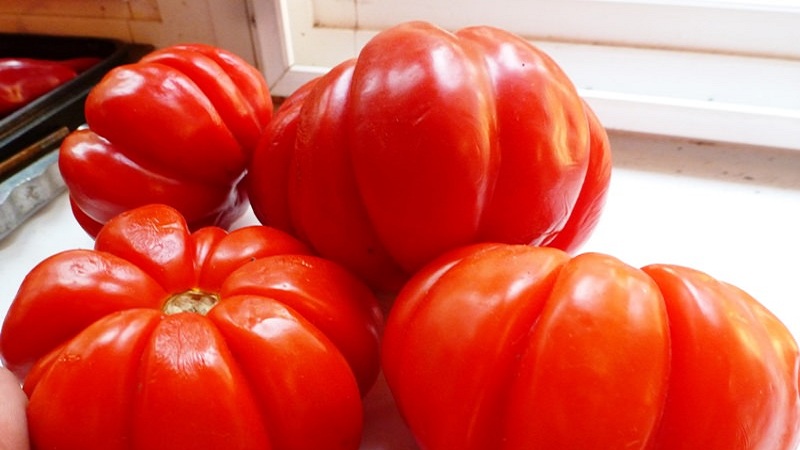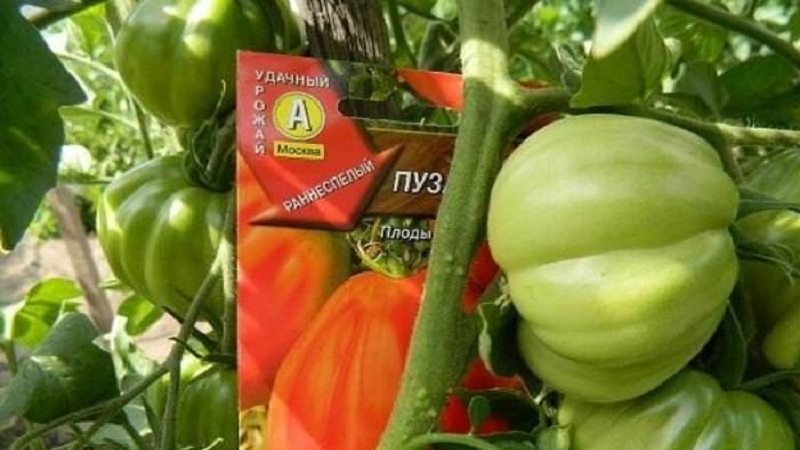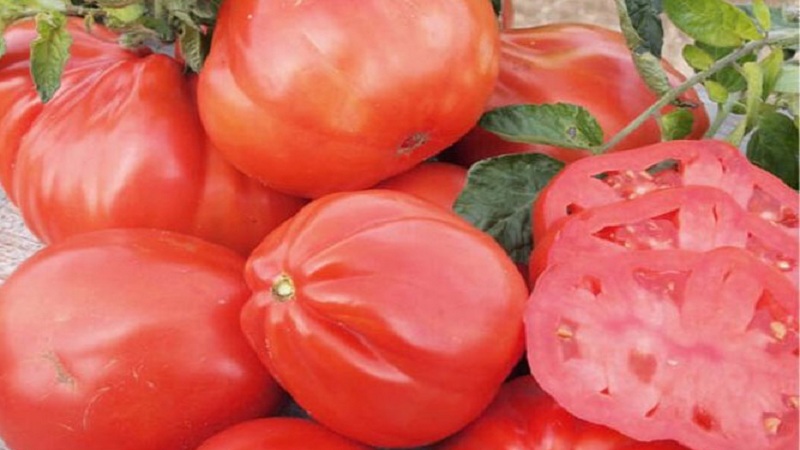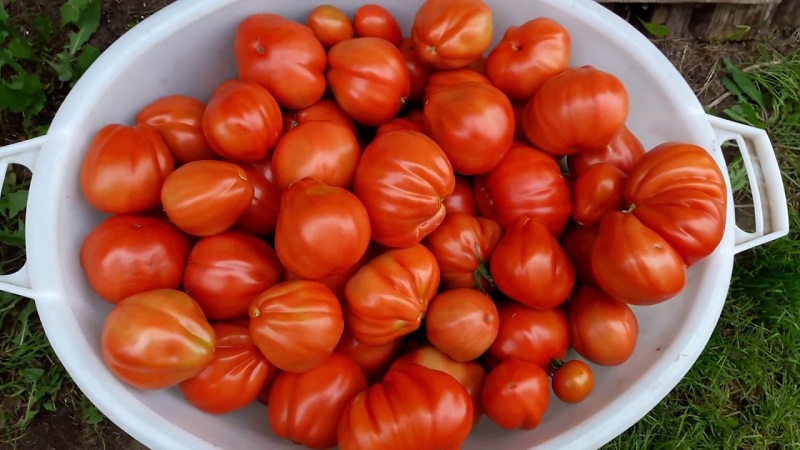Is it worth trying to grow the Puzata Khata tomato and how it might appeal to beginners and experienced farmers
Puzata khata tomatoes are an interesting variety that deserves attention due to their ease of care, high yield, early ripening, immunity to viral and bacterial infections. The original ribbed shape of the fruit, the sugar juicy pulp will leave few people indifferent.
We have prepared for you information about the characteristic features, features of successful agricultural technology of the variety in greenhouses and open field.
The content of the article
Description of the variety
The early ripe tomatoes Puzata khata are a product of the selective work of the biologists of the Aelita agricultural company. The variety was included in the State Register of Russia in 2013. Suitable for indoor cultivation in the northern regions and outdoors in the southern regions.
The photo shows the Puzata khata tomatoes.

Features:
Bushes indeterminate, grow up to 2 m in height in greenhouse conditions and up to 1.5 m in the garden. Thin stems require a garter to a trellis or supports, as they can break under the weight of large fruits. To obtain a rich harvest, the plants are pinned and formed into 1-2 stems.
Leaves are medium-sized, dark green in color. The type of inflorescence is intermediate. Peduncle without articulation. Ovaries with 4–6 nests are formed on each bush.
Fruit characteristics and yield
Tomatoes have an original pear-shaped ribbed shape. It resembles a purse gathered at the top. As it ripens, the shape evens out, becomes more rounded. Unripe fruits are light green in color, without a spot at the stalk. Ripe tomatoes take on a red tint.
The pulp is moderately dense, sugary multichamber. The average weight of the fruit is 250–300 g, the maximum weight is 700 g. The peel is of medium density, does not crack, which allows the tomatoes to be stored for a long time and transported over long distances. Fruits can be picked unripe and ripened on the windowsill. At the same time, the taste does not get worse.
The size of tomatoes is influenced by the growing conditions, the amount of dressings applied, glaze and planting density.
The first fruits ripen 100–110 days after sowing the seeds. Productivity - 8-10 kg per square meter.
Growing seedlings
For cultivation, seeds are used, purchased in a store or collected from fruits. Seedling care includes watering and fertilizing.

Soil preparation and sowing
The seedling soil should be light and nutritious. Ready-made substrate in bags for growing tomatoes or soil made by yourself is suitable. To do this, mix the garden soil with humus in equal parts and add a little ash. This allows you to achieve optimal soil acidity.
For growing tomatoes, the ideal pH is 5-6. To check, use special test strips that are sold in gardening stores.
The soil is pre-disinfected in an oven, microwave or poured with a strong solution of potassium permanganate.
Seeds from bags do not need to be disinfected: the manufacturer has already taken care of this. Those that were collected by hand from previously grown fruits are soaked in a dark pink solution of potassium permanganate for 30 minutes. A warm 2% hydrogen peroxide solution is also suitable. The exposure time is 10 minutes.
To increase germination, the seeds are kept in the preparations "Epin", "Zircon".
Sowing is carried out 60–65 days before transplanting into the ground.The material is planted in boxes or immediately in plastic or peat glasses to a depth of 1 cm. Sprinkle with a layer of earth on top, watered and covered with plastic wrap. Seeds hatch at a temperature of +23 ° C for 5-6 days.
Seedling care
After the sprouts appear, the film is removed and the containers are taken to a place with sufficient lighting, preferably from the south side... The temperature should be 5–10 ° C lower. This strengthens the root system and increases the plant's hardiness.
If the seeds were planted in common pots, after the appearance of 2-3 true leaves, the seedlings dive into glasses. Sprinkle the seedlings in separate containers with earth as they grow.
Seedlings of the Puzata khata variety look weaker in comparison with other tomatoes, therefore they need to be fed weekly with small doses of humate or fertilizers "Baikal", "Shining", "Effekton", "Agricola", "Ideal". The dosage is indicated on the package.
Watering is moderate, after the topsoil has dried.
A week before the planned planting in the ground, the seedlings are taken out into fresh air for hardening. This will help plants adapt faster to new conditions. Initially, the seedlings are left for 30 minutes, then for 1 hour. The time is gradually increased.
At the end of the week, the seedlings should stand in the fresh air all night. During this period, watering is limited to a minimum.
Cultivation of tomatoes
Agrotechnical methods are standard and include preparing the soil for planting, pinching bushes, weeding and loosening the soil, moderate watering and frequent fertilization.

Landing in the ground
The soil for growing tomatoes is prepared in the fall. For this, the earth is dug up, weeds are removed and humus is introduced. In the spring, re-dug up, fertilize with humus at the rate of: 1 bucket per 1 m².
The planting of mature seedlings begins in the second decade of May or in the first decade of June, depending on the region. Holes for seedlings are dug to a depth of 20 cm, each is poured with a strong solution of potassium permanganate, a handful of ash is poured on top. Seedlings in pots are abundantly moistened and transferred together with a lump of earth into the pits. No more than 3-4 bushes are planted on 1 m².
Given the need for a garter, the seedlings are placed next to the trellises, to which the stems and brushes with fruits are subsequently tied.
Stealing
To increase fertility, they try to form 1-2 stems on the bushes. The first stepson is left under the flower brush. New shoots and lower leaves are removed. It is important to ensure that the stepsons do not grow more than 5 cm in length. It is advisable to remove them with scissors or carefully break off by hand.
In order for tomatoes to grow large and juicy, farmers are advised to leave no more than 8 brushes and pinch the growing point at the end of the growing season.
Advice... In order not to confuse shoots with flower brushes, remember that the former grow from the axils of the leaves, the latter are formed from the stem.
Watering, weeding and loosening
After planting the plants, the soil is abundantly moistened. Then watered with warm water once every 7 days. In drought, the frequency of irrigation is increased.
The beds are weeded and weeds removed. Frequent loosening of the soil saturates it with air and facilitates the access of moisture to the roots.
Mulching the soil with sawdust, pine needles, peat, straw will help to simplify the maintenance. This will retain moisture in the soil and will be an excellent prevention of bacterial diseases.
Top dressing
To obtain a rich harvest, it is important to frequently fertilize plants with minerals and organics:
- Manure diluted in water in a ratio of 1:10 and insisted for 8-10 hours. The resulting mixture is watered under the root of the bushes.
- Nitrogen fertilizers applied to the ground before the flowering of tomatoes. For 10 liters of water add 1 tbsp. l. nitrophosphate. The resulting solution moisten the soil under the vegetables.
- Mineral complexes work great: "Kemira lux", "Crystalon", "Solution", "Tsitovit". They make up for the deficiency of potassium, phosphorus, magnesium, zinc, manganese. Increases the number of ovaries, accelerates maturation.Apply funds 1 time in 2 weeks for foliar feeding.
- Superphosphate treatment of bushes spend 1 time in 2 weeks. For 10 liters of water, you will need 40 g of ash, 20 g of superphosphate.
Possible difficulties
The Puzata Khata variety is unpretentious in care, grows well in any climatic conditions, and is resistant to most diseases. Gardeners note some dryness of the fruit and hollowness near the stalk. This often happens due to insufficient watering and feeding.
Diseases and pests
The culture is resistant to Alternaria, fusarium, verticillosis and tobacco mosaic virus.
Due to the early maturity, tomatoes do not have time to get infected late blight, as indicated by numerous reviews of farmers.
However, preventive measures will not hurt:
- fumigation of greenhouses with sulfur bombs;
- mulching the soil with sawdust, peat, hay and needles;
- regular fertilization with phosphorus and potassium;
- disinfection of soil with copper sulfate;
- weeding of beds.
To combat insect pests - aphids, whiteflies, spider mites - use means "Flumite", "Fitoverm", "Aktara", "Epin", "Borneo", "Zircon".
Traditional methods are no less effective:
- Dilute 25 g of wood ash, 25 ml of soap in 5 liters of water, strain and use for treating bushes 2 times a month.
- Pour 200 g of tobacco shag into 5 liters of boiling water, leave for two days in a warm place. Then carry out three times treatment with an interval of 3 days.
- Pour 150 g of onion husks with 10 liters of water, leave for 8 hours, then add 50 g of liquid tar soap. Process the bushes once a week.
Slugs are collected by hand after sunset or irrigate plants with a solution of ammonia (4 tablespoons of substance per 10 liters of water).
Growing in open and closed ground
Caring for Puzata khata tomatoes in the garden and the greenhouse does not differ much. It is important to observe the irrigation and fertilization regimes.
Seedlings are transferred to the greenhouse not earlier than mid-April, to open ground - in the second or third decade of May.
After planting in the garden, you can install a temporary greenhouse: put arcs of thick wire and cover with foil. Place for plants is chosen on the south side, without drafts. It is important that the water does not stagnate in the beds.
In greenhouse conditions, the frequency of watering is increased up to 2 times a week, especially when it is hot outside. Frequent ventilation ensures a favorable indoor climate.
Harvesting and application
The first tomatoes ripen in 100-110 days from the moment of sowing. Uneven fruiting allows you to enjoy the harvest for 3-4 weeks.
Tomatoes are ideal for fresh consumption due to their sugary and juicy pulp. They are used to prepare rich pastas, sauces, soups, stews, marinated in pieces for the winter. However, a large number of chambers do not allow preparing tomato juice of the required consistency.
Advantages and disadvantages

The table shows the main advantages and disadvantages of the variety:
| pros | Minuses |
| High productivity | Necessity garters bushes due to the fragility of the stems and large fruits |
| Sugar pulp is suitable for dietary nutrition | Demanding soil composition |
| Excellent keeping quality of fruits | The need for pinching and forming bushes |
| Unusual shape of tomatoes and large size | The need for constant application of mineral and organic top dressing |
| Resistance to major diseases of nightshade | High |
| Long distance transportation | It tolerates transportation well |
Reviews
Reviews of farmers about the Puzata khata variety are somewhat contradictory: some praise the culture for its unpretentious care, others are unhappy with the need for frequent feeding and the inexpressive taste of the fruit.
Irina, Krasny Yar, Astrakhan region: “My mother shared with me the seedlings of tomatoes Puzata khata. I planted a few bushes in the garden. The variety is fruitful (they harvested 9 kg per sq. M), the fruits are large, fleshy, sweet, without sourness. The culture loves moderate watering and fertilization.If you follow the rules of agricultural technology, you can get a decent harvest. I heard many negative reviews that the fruits grew small and tasteless. From my own experience I was convinced that everything depends on the fertility of the soil. "
Ivan, Lipetsk: “There was an experience of growing varieties in a greenhouse the year before last. I didn't like the tomatoes at all. The color is some kind of orange, the pulp is dry, there are many voids inside. I tried to pickle for the winter - failed. Banks exploded without standing a month. "
Ulyana, Vyksa, Nizhny Novgorod region: “I have been growing these wonderful tomatoes for three years in a row in a greenhouse. To achieve abundant fruiting, I advise you not to spare fertilizers. I use chicken manure and ready-made mineral complexes with potassium, magnesium, phosphorus. I water it once a week, sprinkle the soil with sawdust. The variety does not suffer from late blight and viral diseases, which greatly simplifies care. Pot-bellied tomatoes are very tasty, sweet, of interesting ribbed shape. "
Conclusion
The Puzata khata variety appeared on the market recently, but has already become popular among large farmers and summer residents. Tomatoes have an original shape, sweet and juicy pulp, ripen early, can be stored for a long time and can be easily transported.
The crop can be grown in vegetable gardens and greenhouses. It does not require special care, but it needs frequent feeding with mineral complexes and organic matter.